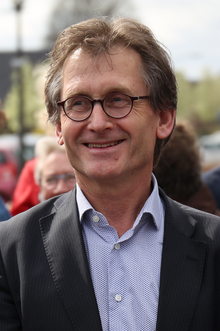Bernard L. Feringa
| Ben Feringa | |
|---|---|

Ben Feringa in 2017
|
|
| Born | Bernard Lucas Feringa 18 May 1951 Barger-Compascuum, Netherlands |
| Residence | Groningen, Netherlands |
| Nationality | Dutch |
| Fields |
Organic Chemistry Materials Science Nanotechnology |
| Institutions |
University of Groningen, 1984–present Royal Dutch Shell, 1979–1984 |
| Alma mater | University of Groningen |
| Thesis | Asymmetric oxidation of phenols. Atropisomerism and optical activity (1978) |
| Doctoral advisor | Hans Wijnberg |
| Known for | Molecular switches/motors, Homogeneous catalysis, stereochemistry, |
| Notable awards | Nobel Prize in Chemistry (2016) |
| Spouse | Betty Feringa |
|
Website benferinga |
|
Bernard Lucas "Ben" Feringa (Dutch pronunciation: [ˈbɛrnɑrt ˈlykɑs ˈbɛn ˈfeːrɪŋɣaː], born 18 May 1951) is a Dutch synthetic organic chemist, specializing in molecular nanotechnology and homogenous catalysis. He is the Jacobus van 't Hoff Distinguished Professor of Molecular Sciences, at the Stratingh Institute for Chemistry,University of Groningen, Netherlands, and an Academy Professor and Chair of Board of the Science Division of the Royal Netherlands Academy of Sciences. He was awarded the 2016 Nobel Prize in Chemistry, together with Sir J. Fraser Stoddart and Jean-Pierre Sauvage, "for the design and synthesis of molecular machines".
Feringa was born as the son of farmer Geert Feringa (1918–1993) and his wife Lies Feringa née Hake (1924–2013). Feringa was the second of ten siblings in a Catholic family. He spent his youth on the family's farm, which is directly on the border with Germany, in Barger-Compascuum in the Bourtange moor. He is of Dutch and German descent. Among his ancestors is the settler . Together with his wife Betty Feringa, he has three daughters. He lives in Paterswolde near Groningen.
Feringa received his MSc degree with distinction from the University of Groningen in 1974. He subsequently obtained a PhD degree at the same university in 1978, with the thesis titled "Asymmetric oxidation of phenols. Atropisomerism and optical activity". Following a short period at Shell in the Netherlands and the United Kingdom, he was appointed as lecturer at the University of Groningen in 1984 and Full Professor, succeeding Prof Wijnberg, in 1988. His early career was focused on homogenous catalysis and oxidation catalysis, and especially on stereochemistry with major contributions in the field of enantioselective catalysis, including monophos ligand used in asymmetric hydrogenation, asymmetric conjugate additions of organometallic reagents, including the highly reactive organolithium reagents and organic and stereochemistry. In the 1990s, Feringa's work in stereochemistry led to major contributions in , resulting in the first monodirectional light driven molecular rotary motor and later a molecular car (a so-called nanocar) driven by electrical impulses.
...
Wikipedia
